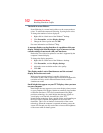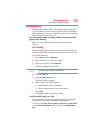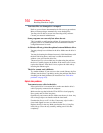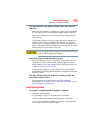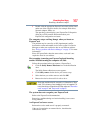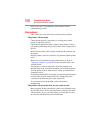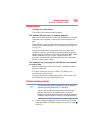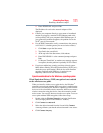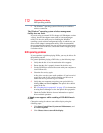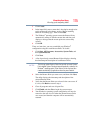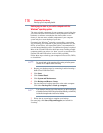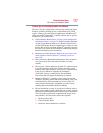
170
If Something Goes Wrong
Resolving a hardware conflict
To determine if your computer has an internal Wi-Fi
®
adapter, check
the device list in Device Manager (part of the Windows
®
Control
Panel, Hardware and Sound). Some Toshiba models may have a
Wi-Fi
®
antenna switch even though they do not have an internal
Wi-Fi
®
adapter.
❖ Verify that signal strength is good using the utility provided
with the Wi-Fi
®
adapter.
❖ If another computer is on the same network, verify that it has
network access, and can connect to the Internet. If, for
example, the other computer cannot browse to a public Web
site, the ISP’s (Internet Service Provider) service may be
disrupted.
❖ Verify that the Service Set Identifier (SSID), or network name,
is correct—i.e., that it matches the SSID assigned to the access
point you are attempting to connect through. SSIDs are case-
sensitive. Toshiba provides a Client Manager utility for setting
and managing SSIDs.
❖ Check the Control Panel’s Hardware and Sound Device
Manager to verify that the Wi-Fi
®
adapter is recognized by the
Windows
®
operating system, and that the driver is loaded.
Carefully note any error messages—these will be very helpful
if you should confer with a support technician at a later time.
❖ Verify that the network connection is configured to obtain its
Internet Protocol (IP) address dynamically:
1 Click Start, and then Network.
2 Click View Status.
3 Click Details.
4 Verify that the DHCP Enabled setting is set to Yes .
5 Click Close.
❖ Use IPCONFIG to verify that the computer has a useful IP
address—one other than the private address of
169.254.xxx.xxx assigned by Windows
®
.
1 Click Start to open the Start menu.
2 Type
Cmd in the search field.
3 At the top-left of the Start menu, click
cmd.exe to open the
command prompt.
NOTE



